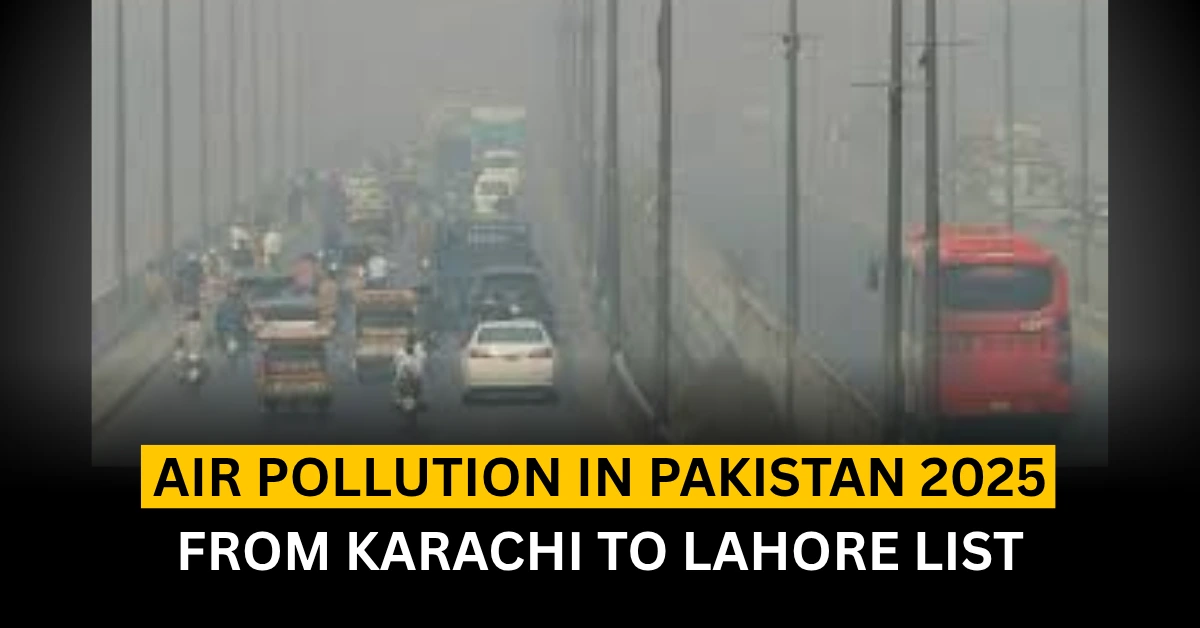According to the latest data from international monitoring agencies such as IQAir and the Air Quality Life Index (AQLI), Air Pollution in Pakistan remains among the highest in the world. Cities including Lahore, Karachi, Faisalabad, Multan, Peshawar, Quetta, Hyderabad, and Islamabad are struggling with dangerously high levels of fine particulate matter (PM₂.₅) throughout the year.
Experts warn that average PM₂.₅ levels in Pakistan’s air are 14–15 times higher than the World Health Organization’s recommended limits. This severe air pollution in Pakistan is estimated to shorten life expectancy by nearly four years nationwide, with losses reaching seven years in Punjab’s smog belt.
Lahore: The Smog Capital
Lahore has become a symbol of the air pollution crisis in Pakistan. In the winter months, the city frequently ranks among the top three most polluted cities in the world, with AQI readings often crossing 300–400 (“hazardous”). The worsening smog is linked to traffic emissions, industrial activity, brick kilns, and crop residue burning. Health experts estimate that long-term exposure here can cut life expectancy by six years or more.
Karachi: Industrial and Transport Hub
As Pakistan’s largest metropolitan city, Karachi faces a different but equally severe challenge. Uncontrolled traffic, industrial emissions, port activity, and construction dust drive AQI levels above 150–200 (“unhealthy”). Unlike Lahore, the city does not experience prolonged winter smog, but the persistent air pollution in Pakistan’s biggest city still poses serious health risks year-round.
Also Read
Punjab EPA Notifies Emission Testing Fees for Vehicles
Islamabad and Rawalpindi
The federal capital and its twin city experience seasonal smog episodes, though their average pollution levels remain lower than Lahore and Karachi. AQI often fluctuates between 100–200, categorized as “unhealthy for sensitive groups.” Rapid urbanization and traffic congestion continue to add to air pollution in Pakistan’s northern regions.
Faisalabad and Multan
- Faisalabad, a textile hub, faces heavy factory emissions and brick kiln smoke, pushing AQI values above 200–300 (“very unhealthy”).
- Multan, surrounded by agricultural lands, suffers from crop residue burning and dust, leading to AQI values in the 150–250 range.
These cities highlight how air pollution in Pakistan’s industrial and agricultural belts creates chronic respiratory illnesses and smog-related visibility problems.
Peshawar and Quetta
- Peshawar struggles with old vehicles, unpaved roads, and brick kilns, with AQI levels in the 150–200 range. Summer dust storms worsen conditions.
- Quetta, due to its mountain-basin geography, traps pollutants in winter. Heavy reliance on coal and wood burning pushes AQI above 200 during colder months.
Both cities illustrate how regional factors compound the problem of air pollution in Pakistan.
Hyderabad and Other Cities
In Hyderabad (Sindh), growing industrial zones and vehicular traffic push AQI levels into the 150–200 range. With limited healthcare facilities and low public awareness, the population remains highly vulnerable to pollution-related illnesses.
Comparison Table: Air Quality in Major Cities
| City | Typical AQI Range | Health Impact |
|---|---|---|
| Lahore | 200–400+ (Hazardous in winter) | Severe smog, respiratory & heart disease, 6–7 years life loss |
| Karachi | 150–200+ (Unhealthy) | Year-round exposure, lung & heart diseases |
| Islamabad/Rawalpindi | 100–200 (Unhealthy for sensitive groups) | Higher risk for children & elderly |
| Faisalabad | 200–300 (Very unhealthy) | Chronic respiratory illness, smog visibility issues |
| Multan | 150–250 (Unhealthy–Very unhealthy) | Smog-related asthma and respiratory diseases |
| Peshawar | 150–200 (Unhealthy) | Dust-related lung infections and illnesses |
| Quetta | 200+ (Winter peaks) | Severe winter smog, respiratory burden |
| Hyderabad | 150–200 (Unhealthy) | Pollution-related illnesses with limited healthcare |
Official Reports & Data
- The Pakistan Environmental Protection Agency (Pak-EPA) issues periodic updates and coordinates with provincial authorities.
- The Punjab Environment Protection Department has published Smog Commission Reports and launched an air quality forecast system.
- According to the AQLI, air pollution in Pakistan shortens life expectancy by 3.9 years nationwide and over 7 years in Lahore.
- The State of Global Air report confirms that nearly 100% of Pakistan’s population lives in areas exceeding WHO air quality standards.
Join our WhatsApp channel. For more related news,
Health and Economic Burden
Air pollution in Pakistan is a leading cause of premature deaths, with an estimated 128,000 fatalities annually linked to poor air quality.
The economic burden is equally high:
- Loss of productivity
- Increased healthcare costs
- Reduced agricultural yields
Children, the elderly, and people with chronic illnesses remain the most vulnerable, facing risks like asthma, lung infections, cardiovascular disease, and even cognitive decline.
Conclusion
From Lahore’s choking smog to Karachi’s industrial haze, no city in Pakistan is spared from worsening air quality. Unless urgent steps are taken—such as stricter vehicle emission standards, regulating industry, curbing open burning, and promoting clean energy—the country will continue to suffer devastating health and economic consequences.




Join The Discussion